While Donald Trump mouthed populist, blue-collar bombast on the campaign trail, once sworn into office, he immediately put old-school commerce chiefs in position to run his empire. For the last two years, these corporate warriors have been chiseling through the barricade of laws, safety rules, and common-sense agreements that protect us from marauding commercial interests.
Reader, beware. Barbarians have entered the city. Washington has been sacked!
Journalists have rarely captured the perversity of Trump’s willing soldiers. In February, the Los Angeles Times offered a glimpse as it spotlighted Ed Calabrese, a professor of toxicology at the University of Massachusetts Amherst whose work tobacco and other poison-producers have long touted.
Calabrese is now helping Trump appointees rewrite public policy to claim that pollution is good for us. Stop and ponder that for a moment: Pollution is good for us.
But few Americans noticed the LA Times piece, which was based on hundreds of emails that the University of Massachusetts released showing Fox News commentator Steven J. Milloy, long a fixture of Washington intrigue, rallying Calabrese and other industry mercenaries and guiding them through D.C.’s dark alleys of influence. The emails find them complaining at times that even Trump’s business-friendly, anti-science policies don’t go far enough.
“This is an amazing assortment of emails as well as individuals,” Lynn Goldman, the dean of The George Washington University’s school of public health and a former deputy secretary at the Environmental Protection Agency, said via email. “It does not surprise me to find that this Administration might be taking science advice at EPA from people like Milloy and Calabrese.”
Milloy And Calabrese March On Washington
With his university credentials, Calabrese provides a patina of scientific respectability to Milloy, a lawyer, sometimes lobbyist and tireless soldier for companies needing to distract the public while they sell harmful or dangerous merchandise.
Milloy runs JunkScience.com and once wrote a science column for Fox News where he beat up on academics and public health advocates who were warning about secondhand smoke, toxic chemicals and pharmaceuticals suspected to cause heart attacks.
Back in 2006, I discovered that “Mr. Junkscience” received a sizeable salary from a tobacco company, which I wrote about for The New Republic. Milloy’s column at Fox later disappeared — even Fox News must feel shame when one of its writers is caught with a hand in the tobacco industry’s cookie jar. (Milloy did not respond to multiple requests for comment about this story.)
Milloy soldiered on, popping up in a Vanity Fair cover story that documented Monsanto’s harassment of small farmers who opposed the company’s move to monopolise agriculture. If you need more highlights of his mercenary career, Google Milloy’s crusade benefiting Exxon to deny climate change or his campaign to support the food industry’s view that soda and junk food don’t make our children obese.
I first noticed Calabrese while burrowing through tobacco documents to better understand Milloy. Tobacco companies apparently took an interest in Calabrese because he promotes a concept called “hormesis,” which argues that tiny amounts of toxic chemicals or radiation might be good for us. Regulatory agencies around the world reject hormesis, and scientists have dismissed it as religion, but the concept excites corporations because it justifies exposing all of us to radiation and toxic chemicals.
Tom Zoeller, a professor of biology at the University of Massachusetts, has followed Calabrese’s work for decades, growing more and more alarmed as his papers “kept getting crazier and crazier.” Eventually, he and his colleagues stopped protesting Calabrese’s writings. “We would have to make a career out of responding to dumb statements,” Zoeller said.
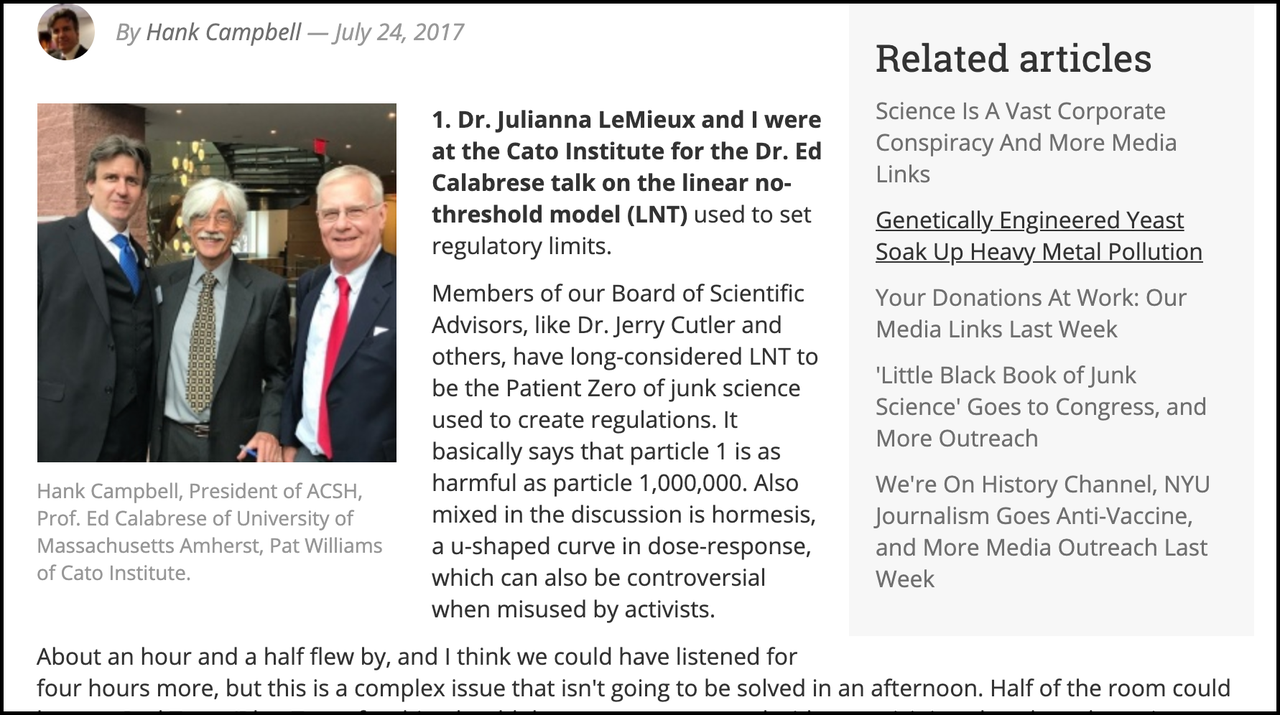
“Tom doesn’t appreciate what I do. That’s OK,” Calabrese said in a recent phone interview. “I think disagreement is good in science, actually. I don’t agree with anybody. I think that’s just how humans are. That’s perfectly good.”
But in Trump, Milloy and Calabrese have found a willing new ally. Milloy has been touted as an EPA adviser in several media outlets, including Trump’s much-hated New York Times and The Wall Street Journal. The administration has never denied it, though Milloy holds no official position. (Read more about how Milloy and others have helped shape Trump’s attack on climate science.)
Shortly after Trump won the election, Milloy bragged about his upcoming book “Scare Pollution” to dozens of his email correspondents, including Richard Yamada, a Trump EPA political appointee. Copied on the email are industry mercenaries including James Enstrom, a tobacco industry-funded researcher whose studies found — unsurprisingly — that tobacco isn’t all that bad; Suresh H. Moolgavkar at Exponent, the industry’s choice consulting firm when research is needed to find that asbestos does not cause cancer and chromium is safe for drinking water; Richard Lindzen, a climate change denialist who works at MIT; Patrick Michaels, a climate change denialist who was then with the fossil-fuel-friendly Cato Institute; and a slew of corporate warriors affiliated with the Heartland Institute, which has taken millions from the Mercer family, which spent millions to elect Trump as well as millions on climate misinformation groups such as the Heartland Institute, Cato and the Manhattan Institute for Policy Research.
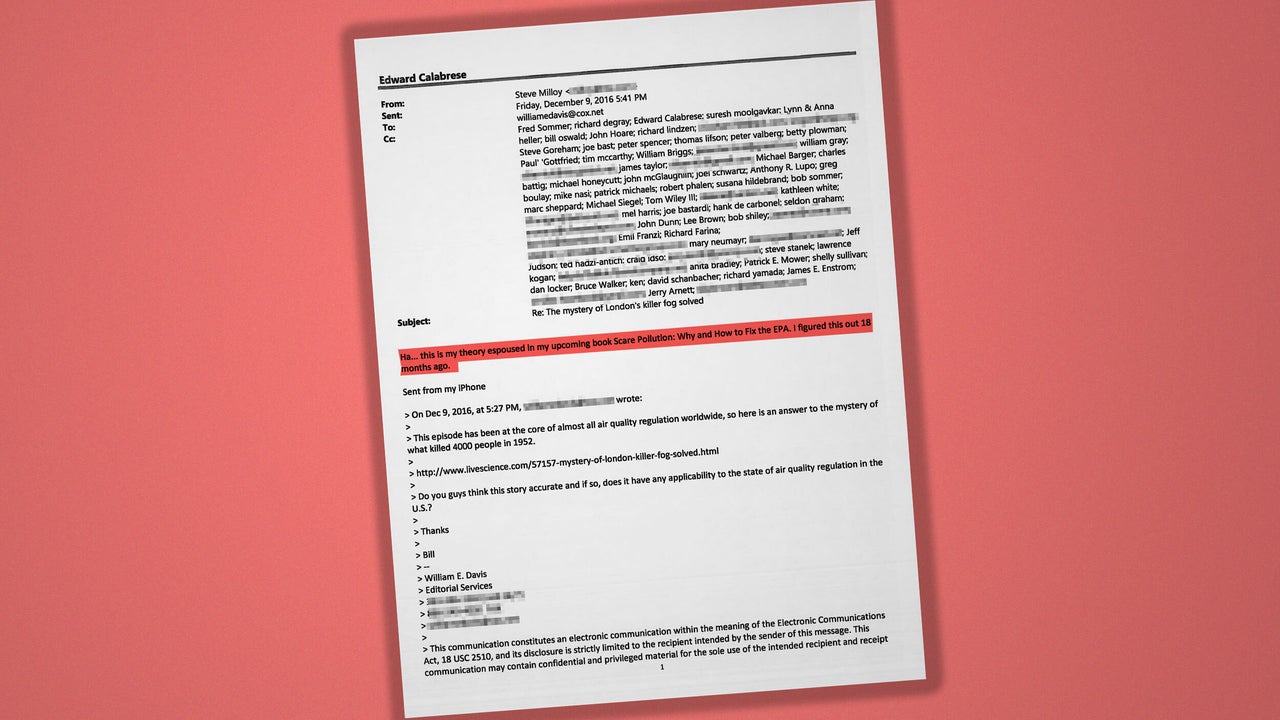
Gathering The Barbarians
Just as the decline of the Roman empire took many centuries, corporate America did not sack Washington overnight. Tobacco companies piloted this disinformation strategy in the 1950s to protect their profits against science pointing to a link between smoking and cancer, and since then, we’ve seen copycat campaigns for fossil fuels, pesticides, foods and plastics.
Milloy is a seasoned expert in this kind of corporate disinformation, and his emails provide perfect insight into his playbook.
For example, in early 2016, Milloy roped Calabrese into signing on to a lawsuit with the Energy & Environment Legal Institute, a small nonprofit funded partly by the coal industry and the Mercer family to file nuisance lawsuits and disrupt climate policy. The suit argues that if the government awards a scientist a grant, then that same scientist is too biased to advise the federal government. It’s a strange contention, to be sure.
But in the crusade against science norms, this is a main line of attack: fabricating an argument that the public health research we fund through our taxes is actually biased against us. Meanwhile, the studies corporations fund to increase their profit margins must be trusted.
After they filed their brief with the court, Milloy emailed Calabrese a story he wrote for the Washington Times promoting the lawsuit. “I am hoping that this helps,” Milloy wrote.
This is classic Milloy: concoct a controversy, then howl it up in the Washington Times or The Wall Street Journal, creating a direct funnel to Washington dinner tables and casting arguments in a direction favourable to industry lobbyists.
“It does not surprise me to find that this Administration might be taking science advice at EPA from people like Milloy and Calabrese.”
- Lynn Goldman, The George Washington University, former deputy secretary at EPA
In an August 2017 email, we see a second Milloy tactic — amplifying outlandish theories as confirmed truths — when he receives an email from the Smithsonian Institution’s Willie Soon, a climate denialist who became nationally infamous when a front-page New York Times story revealed that he was being funded by fossil fuel interests. Soon’s email to Milloy contains a link to an odd Daily Caller article.
The article states that the EPA based its air pollution rules on fabricated data and has a screaming all-caps headline, “EXCLUSIVE.” That would be a heady finding indeed. But if you slow down and read past the title, you find The Daily Caller’s claim of fraud is itself fraud — based on allegations by some guy whose website states that he is an independent contractor with no Ph.D. and no academic or government affiliation. Furthermore, his amazing accusations of fraud have not been peer-reviewed.
So who is he? The Daily Caller’s source is some guy who hung a poster up at a science conference and then sent letters to some journals. Nonetheless, Milloy amplifies this nonsense by forwarding Soon’s email to around a dozen of his followers. But it gets better.
In his email, Milloy alleges that poster guy has a novel hypothesis: Humans learned to tolerate carbon monoxide when our ancient ancestors started using fire. Apparently, cavemen and women sat around fires for so many generations that we evolved to safely breathe in smoke. Since we stopped sitting around campfires every night — get this — the human species now out-gases carbon monoxide. Milloy finishes this theory with a flourish, noting that this is “possibly causing some low level health issues such as menstrual discomfort.”
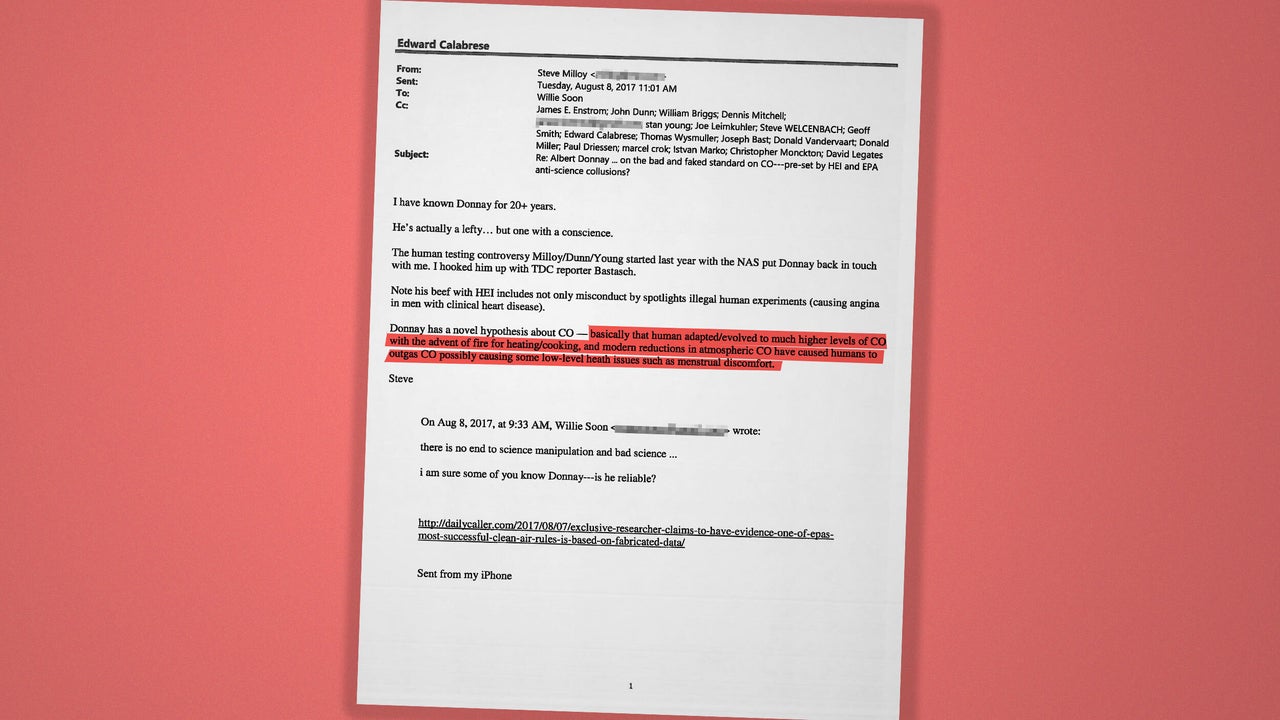
Blowing The War Horn For “True And Willing Warriors”
Other emails highlight equally disturbing behaviour. In late 2017, Breitbart announced that Trump adviser Sebastian Gorka was starting a “MAGA phase 2” project to support the president from outside the White House. The Smithsonian climate change denialist, Soon, then sent an email blast to collect signatures for a letter offering scientific support for Gorka’s effort.
“[W]e suggest that we keep this list small to only the true and willing warriors and scientists but if you have good names, please let us know,” Soon wrote.
Milloy forwarded this to his group, which included several members of the Heartland Institute, Trump’s recent science adviser pick William Happer, and Christopher Monckton, a descendant of British aristocracy whose major claim to fame is yammering about climate denial and receiving a cease-and-desist letter from the British House of Lords for falsely claiming to be one of its members.
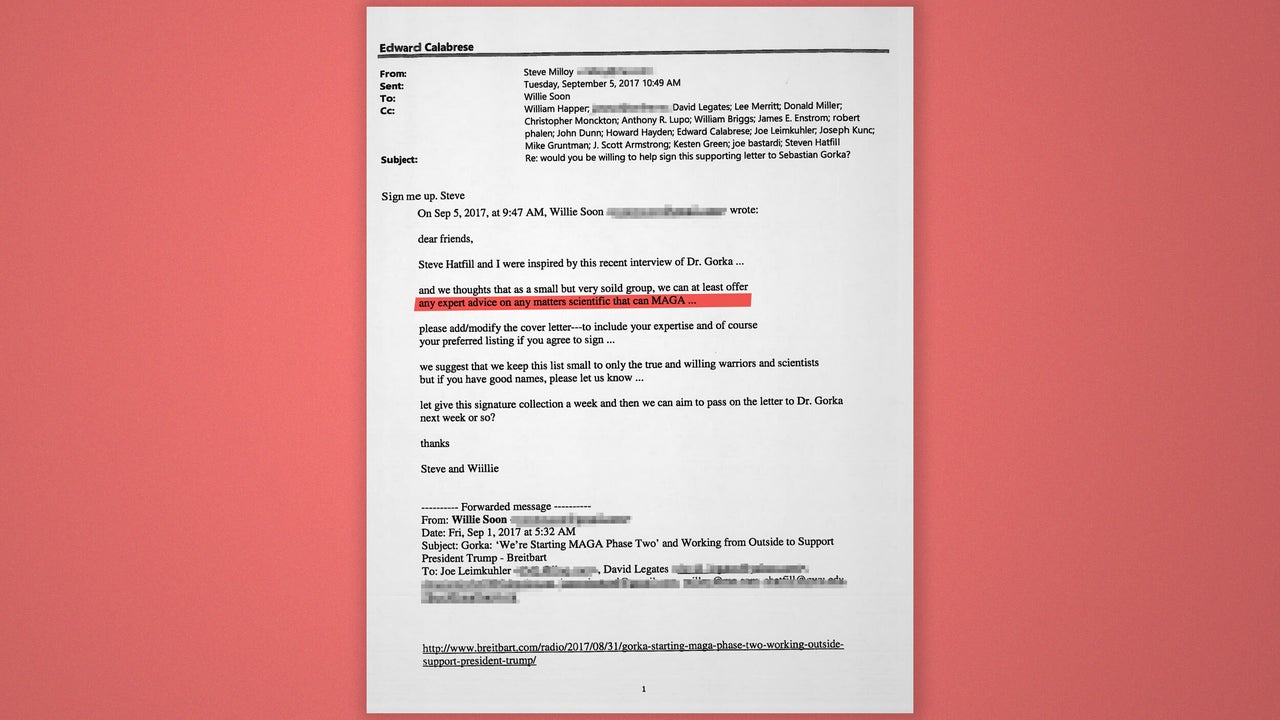
Some weeks later, Soon emailed the group that Trump had picked William Wehrum to head the EPA’s office overseeing air pollution. Wehrum had served in the EPA during the George W. Bush administration, but when Bush later selected him for a senior nomination, Democrats blocked the appointment because Wehrum had a history of ignoring science and taking positions that benefited the industries he’d represented as a lobbyist.
But to Milloy’s crowd, anyone associated with the George W. Bush EPA was a Republican In Name Only “scared to death of the green machine.”
“Think I could have about an hour to wood shed him and kick him around on the lies, the deceit, the scaremongering that went on when [Bush] was pres,” wrote John Dunn, an affiliate of the Heartland Institute, who has railed against research that found benefits from smoking bans.
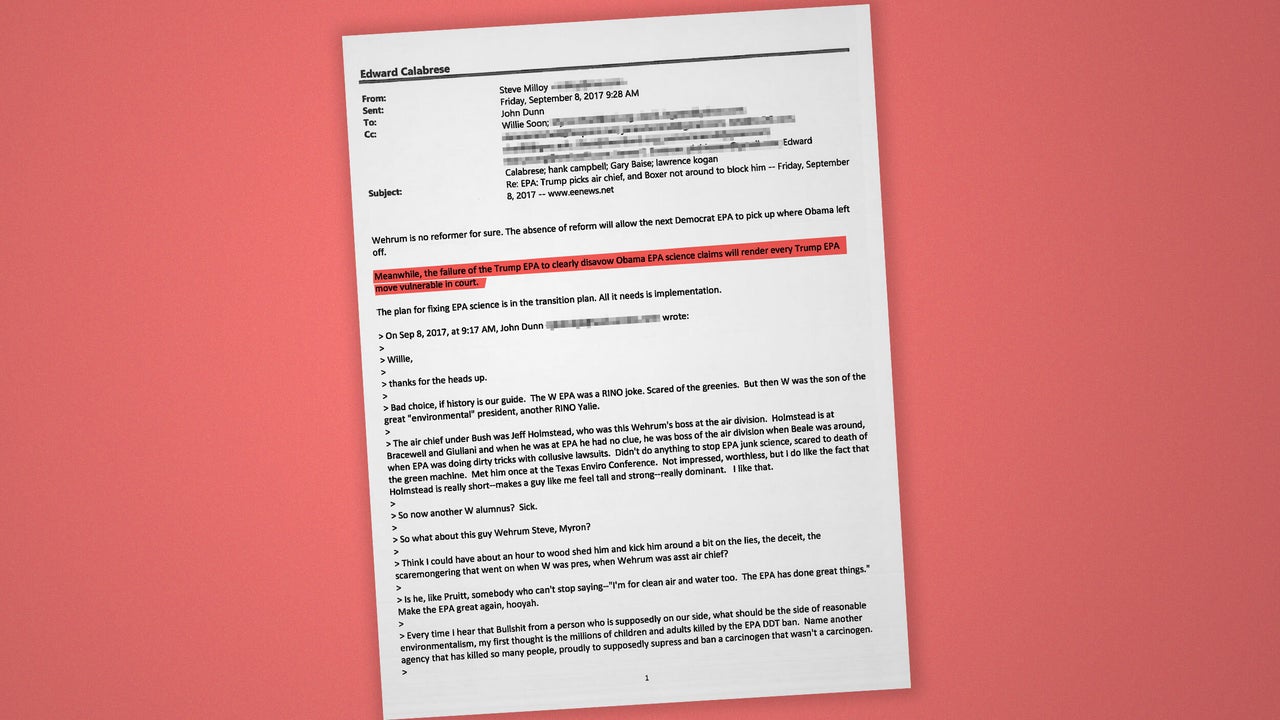
The Senate confirmed Wehrum’s appointment, and he became the focus of a congressional probe after The Washington Post reported that he had not recused himself from matters involving his former lobbying clients. He abruptly resigned from the post on June 26.
In another incident, Milloy and Calabrese expressed disappointment when Trump’s nominee to run an EPA chemical program, University of Cincinnati professor and chemical industry consultant Michael Dourson, withdrew from consideration. Dourson withdrew after Marines complained that his work for chemical companies downplayed the dangers of pollution at Camp Lejeune in North Carolina, prompting that state’s Republican senators to indicate they could not support him.
“This is terrible,” Milloy writes. “Dourson is a very qualified guy. There is a real fear in Congress of someone doing actual science at EPA.”
“Too bad for Mike, the EPA and the country,” Calabrese responds.
In an interview, Calabrese insisted that his relationship with Milloy is almost nonexistent and that he bumped into Milloy one night at dinner after he had gone to Washington to give a talk on regulating chemicals and radiation. Pressed further, Calabrese admitted that the talk and dinner were for the Cato Institute, which has long campaigned against regulations. Members of the American Council on Science and Health also attended and ran a brief on Calabrese’s talk, describing current chemical regulations as “Patient Zero of junk science.”
Despite Calabrese’s protest, dozens of emails imply that he had a very chummy relationship with Milloy and was eager to seek advice and have Milloy promote his work. “You are the very first person to receive this new paper,” Calabrese wrote in a typical exchange. “Please help the world to see it.” In one paper, Calabrese concluded that laws protecting us from chemicals and radiation were “born from the womb of blatant dishonesty within a framework of ideological science.”
After posting many of Calabrese’s pieces to Junkscience.com, Milloy suggested a “popular treatment for your great work on this. Might help lazy people get up to speed.” Milloy also advised asking the chemical industry to fund this project.
“I know there are people inside the agency that are very sympathetic to my viewpoint.”
- Ed Calabrese, professor at University of Massachusetts Amherst advising Trump EPA
At times, Calabrese expressed concern that their campaign to destroy Washington norms for regulating pollution might be a bit extreme, because even some in the industry “are afraid to challenge the status quo.” Milloy agreed. “Someone is always a problem. At [American Petroleum Institute] for example, BP & Shell oppose funding projects that question EPA air quality ‘science.’”
But in April 2018, Calabrese’s campaign to alter science met some major success, as suggested by an email from Clint Woods, a deputy assistant in the EPA air office. Before taking the government job, Woods worked on energy policy for the American Legislative Exchange Council, which has run state-level opposition to EPA safety regulations. He was also the first executive director of the Association of Air Pollution Control Agencies, a renegade regulatory coalition that has been criticised as a cover for fossil-fuel interests.
“I hope all is well,” Woods wrote, asking Calabrese if he had time to discuss policy matters. “I know it has been a few years since we had the chance to work together.”
Calabrese was then sent a copy of a draft regulation on “Strengthening Transparency and Validity in Regulatory Science” marked “DRAFT-PREDECISIONAL-DELIBERATIVE.” Calabrese sent back suggestions on language and other changes and says that EPA officials took some of his advice.
“Thanks so much!” Woods replied.

Woods later notified Calabrese that the regulation was moving forward and included a supportive quote the agency had drafted for Calabrese: “The proposal represents a major scientific step forward by recognising the widespread occurrence of non-linear dose responses in toxicology and epidemiology for chemicals and radiation and the need to incorporate such data in the risk assessment process.”
“Congratulations!!! This activity is critical” Calabrese responded. “I am good with the quote.” The government’s current regulation of chemicals and radiation has “very corrupt origins,” Calabrese added.
The phrase “non linear dose response” is another way of saying “hormesis,” and after the regulation was released in April 2018, climate denialist Pat Michaels howled up Calabrese’s contribution on the Cato Institute’s website: “EPA is proposing a major change in the way we regulate radiation, carcinogens, and toxic substances in our environment.” Michaels left Cato earlier this year.
But as often happens in the uncertainty of combat and the fog of war, confusion is common and perspective is sometimes lost. Calabrese’s EPA victory might turn into defeat.
After reviewing the emails, former EPA general counsel Scott Fulton told HuffPost that while Woods likely did not break the law in sharing privileged documents with Calabrese, he did betray the public trust — not to mention opened up the agency to congressional probes and lawsuits demanding documents on how EPA created this rule. Fulton said courts are likely to side with legal challengers seeking to get the rule thrown out when it’s actually finalised.
“While it is difficult to say whether a court would find bias, and therefore arbitrariness, under these facts, this type of engagement could provide further fuel to a substantive challenge to the rule,” Fulton wrote in an email.
An EPA spokesperson said that the agency is reviewing more than 597,000 comments on the rule and determining next steps.
Calabrese said he has done his best to bring his war against pollution rules to Washington. The rest lies with Trump administration.
“I know there are people inside the agency that are very sympathetic to my viewpoint,” Calabrese said, adding that Trump’s political appointees are playing it close to the vest, concerned that if they write anything down, those emails or documents might become public. “If they want to use me for my work, that’s up to them.”
